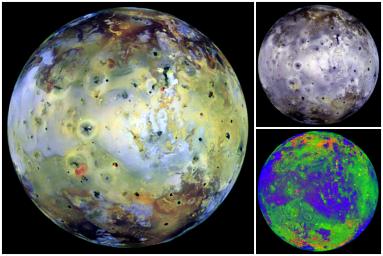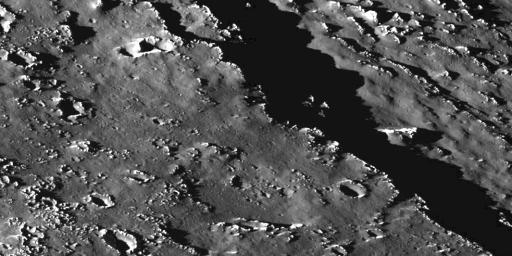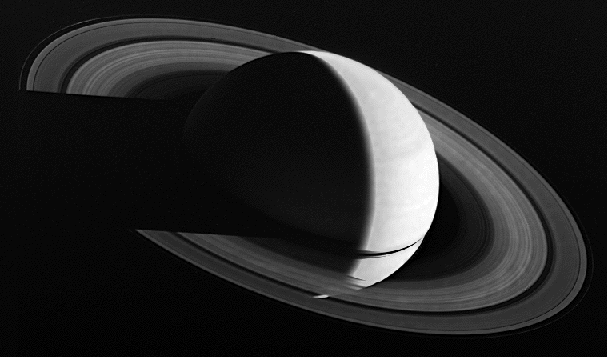Lecture 21 - The Outer Planets and their Satellites (12/1/98)
 Jupiter --- | ---
Minor Planets
Jupiter --- | ---
Minor Planets


Reading:
Chapter 6, 7-1 (ZG4)
Saturn, from Voyager 2. (JPL/NASA)
 |
Key Question: |
Which planets have rings and why?
|
|---|
 |
Key Principle: |
The Roche Limit and Tidal Disruption
|
|---|
 |
Key Problem: |
What are the ridges, spokes and gaps
in Saturn's rings due to?
|
|---|
 |
Key Quote: |
|
|---|
Investigations:
- Giant Planet Magnetospheres
- Why does Jupiter have such a strong magnetic field?
- Why are some giant planet magnetic dipoles offset from the
axes and centers?
- How much larger is Jupiter's magnetic dipole moment than the
Earth's?
- How much iron would you expect there to be in Jupiter's core?
- How do the satellites interact with the giant planet magnetospheres?
- What is the Io Plasma Torus?
- How are Jupiter's aurorae created?
- How is synchrotron radiation generated?
- What is the origin of Jupiter's decametric radiation and
what is its wavelength?
- Gas Giant Atmospheres
- What are the two primary atmospheric constituents?
- What are the clouds made of?
- At what level are the clouds?
- What are zones and belts?
- What is convection?
- What is the Great Red Spot? How long has it been around?
- Why can giant planet storms last such a long time?
- The Outer Outer Planets
- What is unusual about the mean density of Saturn?
- Why does Saturn have a lower helium abundance in its atmosphere
than the other giants? Where did it go?
- Are Saturn's "white spots" similar to Jupiter's Red Spot?
- How are the clouds of Saturn, Uranus and Neptune different than
those of Jupiter?
- Why might the band and zone patterns on Uranus be fainter than those
on the other planets?
- What is the "Great Dark Spot" on Neptune?
- Why do Uranus and Neptune have a bluish or greenish tint?
- Is there a trend in cloud compositions with mean temperatures?
- What is unusual about Pluto and Charon?
- What is Pluto's composition and what evidence do we have?
- Where did Pluto get its tenuous methane atmosphere?
- Satellites of the Giant Planets
- How are the outer planet satellites similar and different to
the inner planets?
- Why are many satellite crusts water ice?
- Why are Jupiter's inner satellites active, while the outer
satellites are cratered?
- Why does Io erupt Sulfur, and Triton erupt Nitrogen, and not lava?
- How did Titan form an atmosphere and keep it?
- Why do the satellites have such fascinating surface features?
- Are all giant planet satellites tidally locked to their primaries?
- How do the satellites perturb each other's orbits?
- Which satellites are captured asteroids?
- Ring Systems
- Why do all gas giants have rings?
- How much mass is in Saturn's rings?
- What is the Roche Limit?
- Are the rings inside or outside the Roche Limit?
- Why can small satellites survive inside the limit?
- What are the rings of Saturn made of?
- How thin are they? How wide? How do they rotate?
- Why are there gaps and ringlets?
- What are orbital resonances?
- Why are the narrow rings kinked, bent, and wavy?
- How do moons shepherd some rings?
- How do you use stellar occultation by the rings to
detect and measure rings?
- How are rings destroyed and replenished?
Explore The Outer Planets:

The Great Red Spot, Voyager 2 (JPL/NASA)
From
JPL's Welcome to the Planets:
See also
The Nine Planets by Bill Arnett.
Satellites of Jupiter:

The vulcanized surface of Io, as seen by
the Galileo orbiter. (Courtesy NASA/JPL)
In the latest passage of Galilieo by Callisto, it beamed back
an image of Io showing the appearance of a
new volcano. This appeared
since its last image taken in April 1997, and shows a patch the size
of Arizona on the tortured surface.

An Arizona-sized volcano appears on Io. (Courtesy NASA/JPL)
The current focus of interest is the icy moon Europa, which appears
to be covered in a crust of water ice, protecting a cold ocean made
of water. In addition, this satellite appears to have a thin atmosphere.
The Jovian system of moons (and a ring) is much like a miniature solar
system (especially early in its history when Jupiter would have been
hot enough to act as a "sun" of sorts!

The cracked icy surface of Europa, from
the Galileo orbiter. (Courtesy NASA/JPL)
Other Galileo Highlights:
An amazing
GIF Animation
of Io Plume:

The Galileo Space Probe has provided many images of Jupiter and
its satellites. In the latest released pictures, the
surface of
the moon Callisto shows complex geology of craters and scarps.

The Valhalla region of the Jovian moon Callisto, from
the Galileo orbiter. (Courtesy NASA/JPL)
The Cassini Mission to Saturn:
The Cassini Mission to Saturn is on its way to a 2004 encounter
with the planets, its rings, and its moon Titan! The spacecraft
was successfully launched on the morning of October 15 after a
two-day delay. The probe will take a roundabout Earth - Venus -
Venus - Earth - Saturn trajectory, using gravity assists at the
intermediate encounters to propel itself to the outer solar
system with maximum efficiency.
The mission was not without controversy, mostly over the use of
72 lbs of radioactive Plutonium in its nuclear power cell. The heat
given off by the decay of this dangerous material supplies the massive
Cassini spacecraft with the necessary power to run its onboard systems
in the sunlight-starved outer reaches of the solar system near Saturn.

Artist's rendering of the view from Pandora, one of the shepherds of the F ring. (Courtesy NASA/JPL)
Rings:

Saturn backlit, Voyager 2 (JPL/NASA)
See also
JPL's Welcome to the Planets and
The Nine Planets by Bill Arnett for more on rings.
 Prev Lecture ---
Prev Lecture ---
 Next Lecture ---
Next Lecture ---
 Astr11 Index ---
Astr11 Index ---
 Astr11 Home
Astr11 Home
smyers@nrao.edu
Steven T. Myers
 Jupiter --- | ---
Minor Planets
Jupiter --- | ---
Minor Planets

 Jupiter --- | ---
Minor Planets
Jupiter --- | ---
Minor Planets














 Prev Lecture ---
Prev Lecture ---
 Next Lecture ---
Next Lecture ---
 Astr11 Index ---
Astr11 Index ---
 Astr11 Home
Astr11 Home